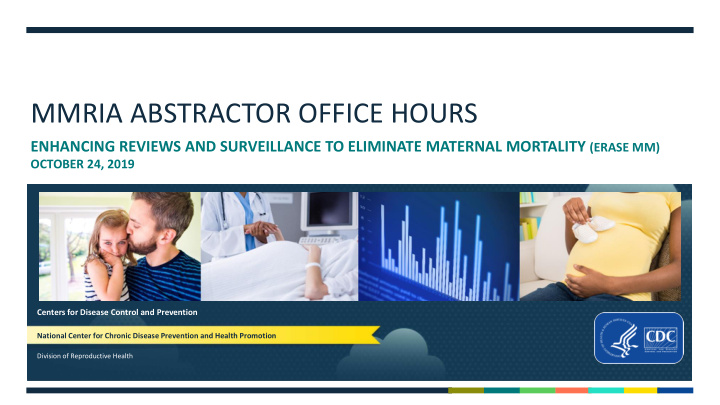



MMRIA ABSTRACTOR OFFICE HOURS ENHANCING REVIEWS AND SURVEILLANCE TO ELIMINATE MATERNAL MORTALITY (ERASE MM) OCTOBER 24, 2019 Centers for Disease Control and Prevention National Center for Chronic Disease Prevention and Health Promotion Division of Reproductive Health
PURPOSE AND PROCESS FOR MONTHLY ABSTRACTOR OFFICE HOURS CALLS Purpose: To promote optimal retrieval and documentation of maternal death case information that supports efficient and effective case review. Process: Hold semi-structured monthly calls to informally discuss: ➢ Access to records/challenges or barriers ➢ Authorities/confidentiality ➢ Data entry into MMRIA ➢ Abstractor procedural guidelines ➢ Developing case narratives ➢ Facilitation of case review ➢ Abstractor Self-Care
Q: How do we capture suicides? • A: It depends. • If not pregnancy-related, complete the checkboxes on page 1. • If pregnancy-related, complete the checkboxes on page 1 AND assign a PMSS-MM code. Most of these will fall under one of the following PMSS-MM codes: • 100 Mental Health Conditions • 100.1 Depression • 100.9 Other psychiatric conditions/NOS 3
4
Q: How do we capture overdoses? • A: It depends. • If not pregnancy-related, complete the checkboxes on page 1. • If pregnancy-related, complete the checkboxes on page 1 AND assign a PMSS-MM code using decision tree. Overdoses will fall under one of the following PMSS-MM codes: • 100 Mental Health Conditions • 100.1 Depression • 100.9 Other psychiatric conditions/NOS • 88.2 Unintentional Injury 5
6
QUESTIONS FROM THE FIELD What have people found is the best way to get records for “in the field” deaths with only a death 1. certificate and/or news article about the death? Call all local OB offices? ➢ Identify other resources that you have authority to search (PDMP, hospital discharge data, Medicaid data) ➢ Contact area hospitals and OB offices ➢ Search social media sources The following link provides information on corner/medical examiner laws by state: https://www.cdc.gov/phlp/publications/topic/coroner.html
QUESTIONS FROM THE FIELD Q: How much detail should the abstractor enter into the MMRIA forms with regards to individual lab results? Can these items simply be grouped? A: The answer is: It depends on what the individual MMRC data analysis/reporting plan is ➢ If there is a particular lab that your team wishes to monitor or report on (e.g. platelets or Hgb) then you would want to place them into their own data field. ➢ If not then you may consider grouping individual items and highlighting the abnormal values in the results box. ➢ You also need to provide the MMRC with adequate details to foster quality case review.
QUESTIONS FROM THE FIELD Q: Should a prenatal quad screen be entered under labs or diagnostics? A: Again this is up to the individual MMRC to decide based upon their data analysis/reporting needs. ➢ The important thing is to be consistent. Q: Is there a way to make the space on left side column of the page where home/summary and forms are listed a bit larger? A: We are aware of this issue and have proposed screen modifications to maximize usable space for MMRIA users in future versions.
QUESTIONS FROM THE FIELD Q: What data elements should be documented on the Committee Decisions Forms for pregnancy- associated deaths? A: ➢ Begin with documenting the Pregnancy-relatedness for all deaths ➢ If pregnancy-associated but not related (and reviewed by the MMRC) or pregnancy-related, complete the checkbox entries on page 1 of the form (lower right hand column) ➢ If pregnancy-related, complete the PMSS-MM cause of death code ➢ If pregnancy-related, complete the Preventability determinations ➢ If pregnancy-related and preventable, complete the recommendations for action
QUESTIONS FROM THE FIELD 2. Does anyone have any examples for notifications or emerging issues one pagers that their state does from the review committee separate from their annual report?
ABSTRACTOR SELF-CARE
ABSTRACTOR SELF-CARE • Tip #2: Take periodic breaks from your work….
ANY ADDITIONAL QUESTIONS?
Recommend
More recommend